Equity & Trusts: An Evaluation of the Three Certainties' Clarity
VerifiedAdded on 2023/05/28
|14
|3963
|167
Essay
AI Summary
This essay critically evaluates the three certainties (intention, subject, and object) in Equity and Trusts law, addressing the statement that they are comprised of conflicting and confusing authorities, leading to a lack of clarity and certainty in their application. It references the landmark case of Knight v Knight and examines various legal precedents to assess the accuracy of this statement. The essay discusses the rationale behind the three certainties, including the protection of trustees and the court's role in giving effect to the testator's intention. It also explores the construction of trust clauses, focusing on certainty of intention, subject matter (property and beneficial interests), and objects, while contrasting discretionary trusts with fiduciary powers. Real-world cases like Paul v Constance are used to illustrate the complexities and ambiguities inherent in determining the certainty of intention and the overall enforceability of trusts. The essay concludes by reflecting on the social equity dimensions of trust law and how the interpretation of these certainties impacts the fair distribution of benefits within society.

1
Paraphrase This Document
Need a fresh take? Get an instant paraphrase of this document with our AI Paraphraser
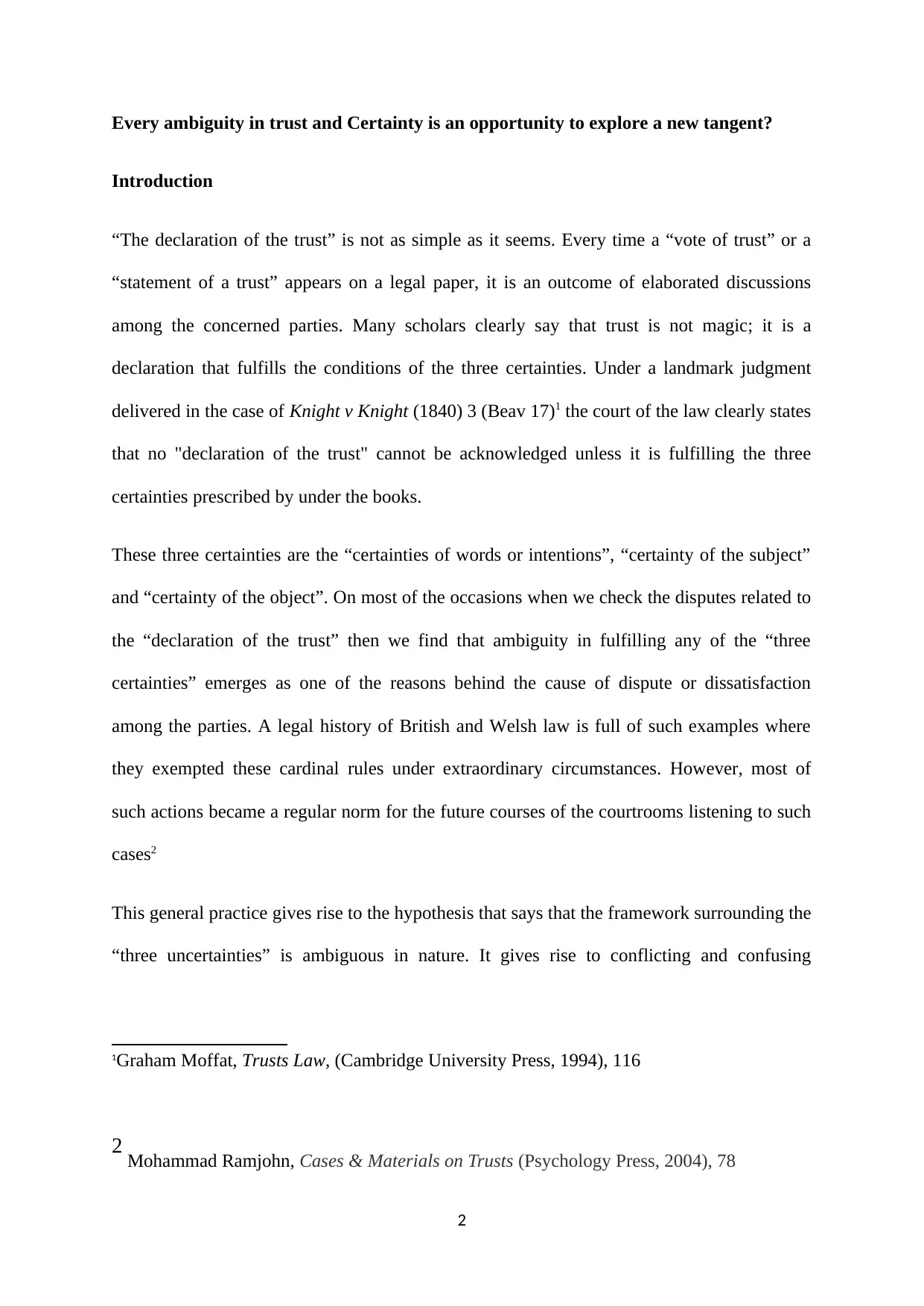
Every ambiguity in trust and Certainty is an opportunity to explore a new tangent?
Introduction
“The declaration of the trust” is not as simple as it seems. Every time a “vote of trust” or a
“statement of a trust” appears on a legal paper, it is an outcome of elaborated discussions
among the concerned parties. Many scholars clearly say that trust is not magic; it is a
declaration that fulfills the conditions of the three certainties. Under a landmark judgment
delivered in the case of Knight v Knight (1840) 3 (Beav 17)1 the court of the law clearly states
that no "declaration of the trust" cannot be acknowledged unless it is fulfilling the three
certainties prescribed by under the books.
These three certainties are the “certainties of words or intentions”, “certainty of the subject”
and “certainty of the object”. On most of the occasions when we check the disputes related to
the “declaration of the trust” then we find that ambiguity in fulfilling any of the “three
certainties” emerges as one of the reasons behind the cause of dispute or dissatisfaction
among the parties. A legal history of British and Welsh law is full of such examples where
they exempted these cardinal rules under extraordinary circumstances. However, most of
such actions became a regular norm for the future courses of the courtrooms listening to such
cases2
This general practice gives rise to the hypothesis that says that the framework surrounding the
“three uncertainties” is ambiguous in nature. It gives rise to conflicting and confusing
1Graham Moffat, Trusts Law, (Cambridge University Press, 1994), 116
2 Mohammad Ramjohn, Cases & Materials on Trusts (Psychology Press, 2004), 78
2
Introduction
“The declaration of the trust” is not as simple as it seems. Every time a “vote of trust” or a
“statement of a trust” appears on a legal paper, it is an outcome of elaborated discussions
among the concerned parties. Many scholars clearly say that trust is not magic; it is a
declaration that fulfills the conditions of the three certainties. Under a landmark judgment
delivered in the case of Knight v Knight (1840) 3 (Beav 17)1 the court of the law clearly states
that no "declaration of the trust" cannot be acknowledged unless it is fulfilling the three
certainties prescribed by under the books.
These three certainties are the “certainties of words or intentions”, “certainty of the subject”
and “certainty of the object”. On most of the occasions when we check the disputes related to
the “declaration of the trust” then we find that ambiguity in fulfilling any of the “three
certainties” emerges as one of the reasons behind the cause of dispute or dissatisfaction
among the parties. A legal history of British and Welsh law is full of such examples where
they exempted these cardinal rules under extraordinary circumstances. However, most of
such actions became a regular norm for the future courses of the courtrooms listening to such
cases2
This general practice gives rise to the hypothesis that says that the framework surrounding the
“three uncertainties” is ambiguous in nature. It gives rise to conflicting and confusing
1Graham Moffat, Trusts Law, (Cambridge University Press, 1994), 116
2 Mohammad Ramjohn, Cases & Materials on Trusts (Psychology Press, 2004), 78
2
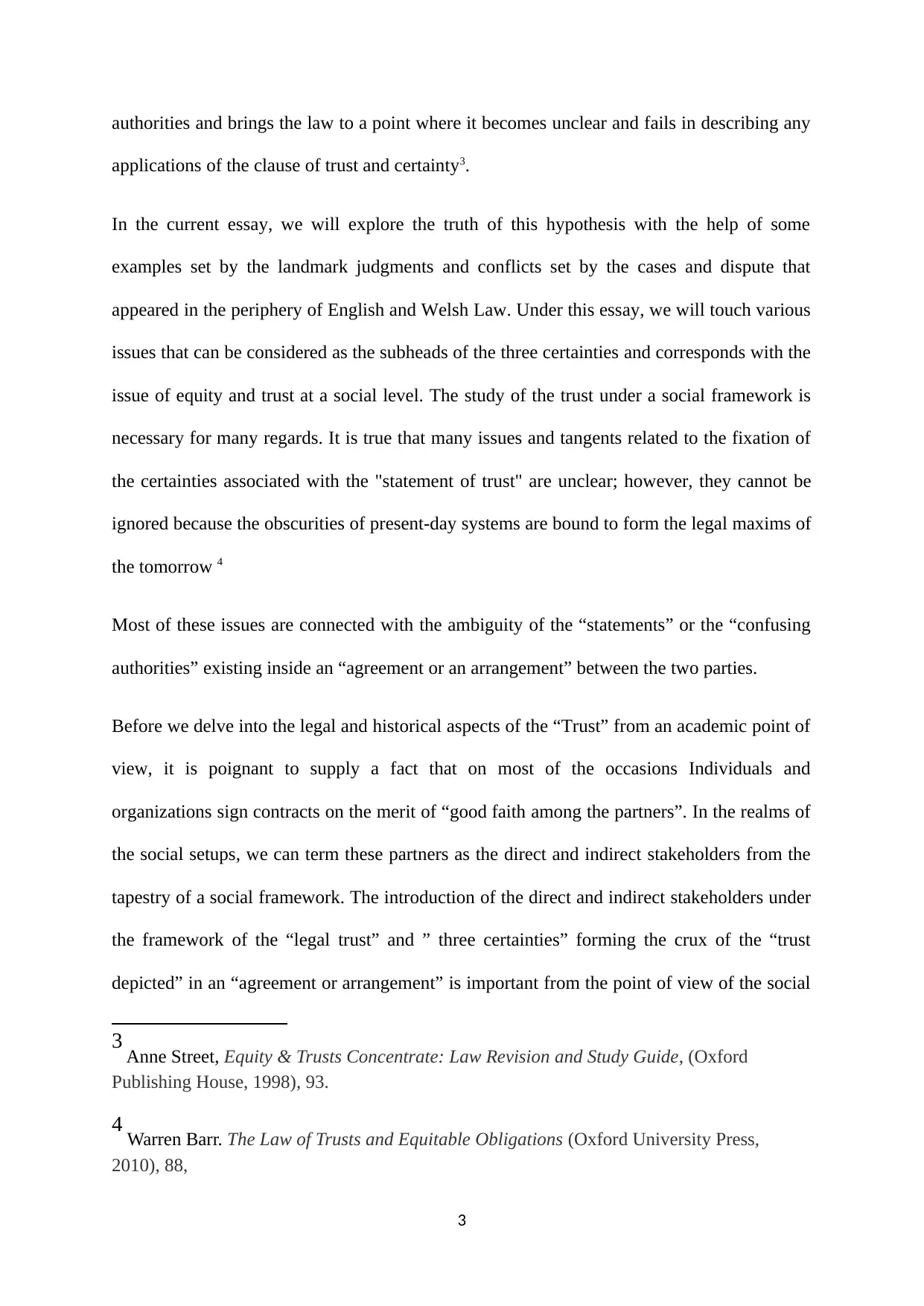
authorities and brings the law to a point where it becomes unclear and fails in describing any
applications of the clause of trust and certainty3.
In the current essay, we will explore the truth of this hypothesis with the help of some
examples set by the landmark judgments and conflicts set by the cases and dispute that
appeared in the periphery of English and Welsh Law. Under this essay, we will touch various
issues that can be considered as the subheads of the three certainties and corresponds with the
issue of equity and trust at a social level. The study of the trust under a social framework is
necessary for many regards. It is true that many issues and tangents related to the fixation of
the certainties associated with the "statement of trust" are unclear; however, they cannot be
ignored because the obscurities of present-day systems are bound to form the legal maxims of
the tomorrow 4
Most of these issues are connected with the ambiguity of the “statements” or the “confusing
authorities” existing inside an “agreement or an arrangement” between the two parties.
Before we delve into the legal and historical aspects of the “Trust” from an academic point of
view, it is poignant to supply a fact that on most of the occasions Individuals and
organizations sign contracts on the merit of “good faith among the partners”. In the realms of
the social setups, we can term these partners as the direct and indirect stakeholders from the
tapestry of a social framework. The introduction of the direct and indirect stakeholders under
the framework of the “legal trust” and ” three certainties” forming the crux of the “trust
depicted” in an “agreement or arrangement” is important from the point of view of the social
3 Anne Street, Equity & Trusts Concentrate: Law Revision and Study Guide, (Oxford
Publishing House, 1998), 93.
4 Warren Barr. The Law of Trusts and Equitable Obligations (Oxford University Press,
2010), 88,
3
applications of the clause of trust and certainty3.
In the current essay, we will explore the truth of this hypothesis with the help of some
examples set by the landmark judgments and conflicts set by the cases and dispute that
appeared in the periphery of English and Welsh Law. Under this essay, we will touch various
issues that can be considered as the subheads of the three certainties and corresponds with the
issue of equity and trust at a social level. The study of the trust under a social framework is
necessary for many regards. It is true that many issues and tangents related to the fixation of
the certainties associated with the "statement of trust" are unclear; however, they cannot be
ignored because the obscurities of present-day systems are bound to form the legal maxims of
the tomorrow 4
Most of these issues are connected with the ambiguity of the “statements” or the “confusing
authorities” existing inside an “agreement or an arrangement” between the two parties.
Before we delve into the legal and historical aspects of the “Trust” from an academic point of
view, it is poignant to supply a fact that on most of the occasions Individuals and
organizations sign contracts on the merit of “good faith among the partners”. In the realms of
the social setups, we can term these partners as the direct and indirect stakeholders from the
tapestry of a social framework. The introduction of the direct and indirect stakeholders under
the framework of the “legal trust” and ” three certainties” forming the crux of the “trust
depicted” in an “agreement or arrangement” is important from the point of view of the social
3 Anne Street, Equity & Trusts Concentrate: Law Revision and Study Guide, (Oxford
Publishing House, 1998), 93.
4 Warren Barr. The Law of Trusts and Equitable Obligations (Oxford University Press,
2010), 88,
3
⊘ This is a preview!⊘
Do you want full access?
Subscribe today to unlock all pages.

Trusted by 1+ million students worldwide
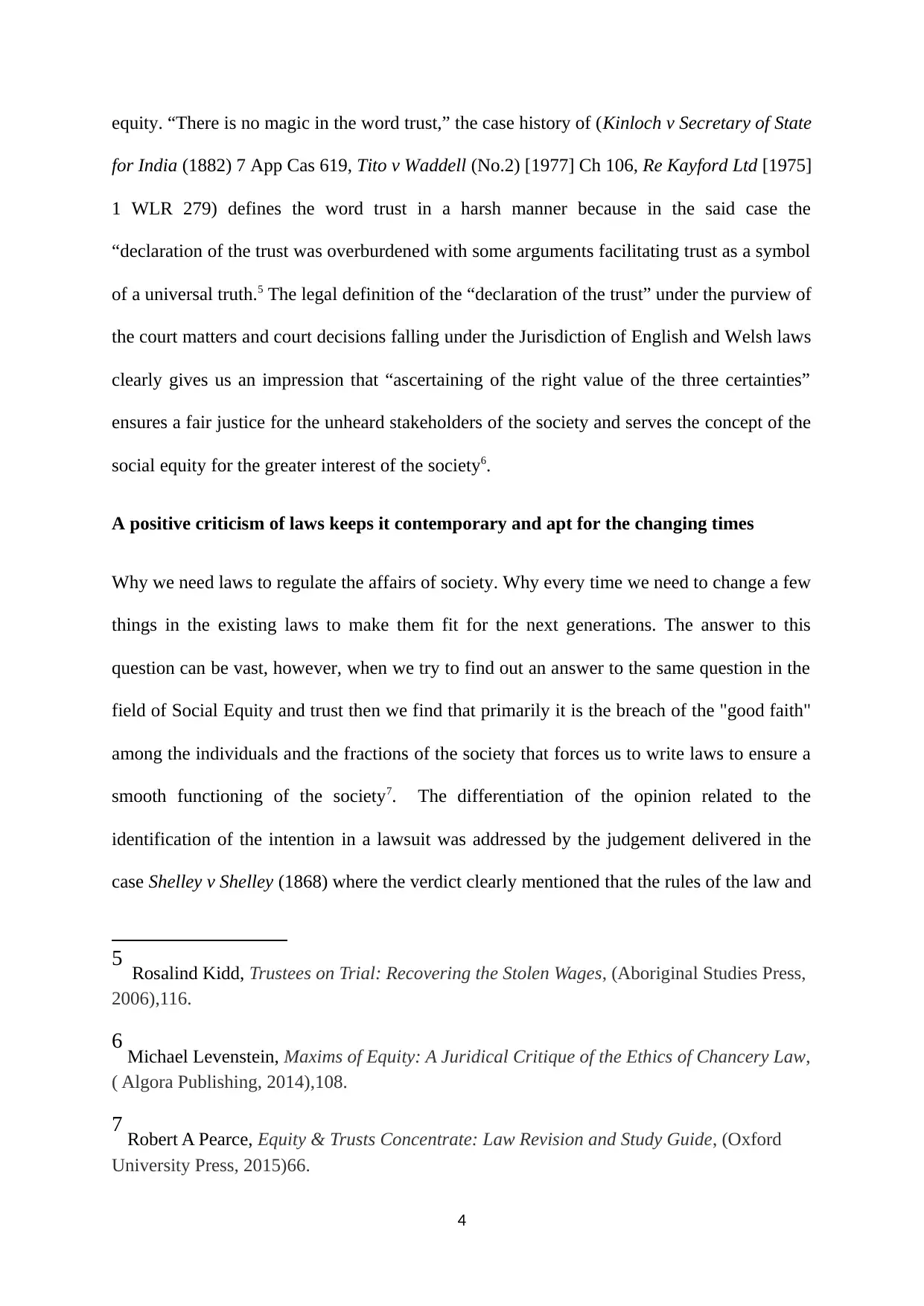
equity. “There is no magic in the word trust,” the case history of (Kinloch v Secretary of State
for India (1882) 7 App Cas 619, Tito v Waddell (No.2) [1977] Ch 106, Re Kayford Ltd [1975]
1 WLR 279) defines the word trust in a harsh manner because in the said case the
“declaration of the trust was overburdened with some arguments facilitating trust as a symbol
of a universal truth.5 The legal definition of the “declaration of the trust” under the purview of
the court matters and court decisions falling under the Jurisdiction of English and Welsh laws
clearly gives us an impression that “ascertaining of the right value of the three certainties”
ensures a fair justice for the unheard stakeholders of the society and serves the concept of the
social equity for the greater interest of the society6.
A positive criticism of laws keeps it contemporary and apt for the changing times
Why we need laws to regulate the affairs of society. Why every time we need to change a few
things in the existing laws to make them fit for the next generations. The answer to this
question can be vast, however, when we try to find out an answer to the same question in the
field of Social Equity and trust then we find that primarily it is the breach of the "good faith"
among the individuals and the fractions of the society that forces us to write laws to ensure a
smooth functioning of the society7. The differentiation of the opinion related to the
identification of the intention in a lawsuit was addressed by the judgement delivered in the
case Shelley v Shelley (1868) where the verdict clearly mentioned that the rules of the law and
5 Rosalind Kidd, Trustees on Trial: Recovering the Stolen Wages, (Aboriginal Studies Press,
2006),116.
6 Michael Levenstein, Maxims of Equity: A Juridical Critique of the Ethics of Chancery Law,
( Algora Publishing, 2014),108.
7 Robert A Pearce, Equity & Trusts Concentrate: Law Revision and Study Guide, (Oxford
University Press, 2015)66.
4
for India (1882) 7 App Cas 619, Tito v Waddell (No.2) [1977] Ch 106, Re Kayford Ltd [1975]
1 WLR 279) defines the word trust in a harsh manner because in the said case the
“declaration of the trust was overburdened with some arguments facilitating trust as a symbol
of a universal truth.5 The legal definition of the “declaration of the trust” under the purview of
the court matters and court decisions falling under the Jurisdiction of English and Welsh laws
clearly gives us an impression that “ascertaining of the right value of the three certainties”
ensures a fair justice for the unheard stakeholders of the society and serves the concept of the
social equity for the greater interest of the society6.
A positive criticism of laws keeps it contemporary and apt for the changing times
Why we need laws to regulate the affairs of society. Why every time we need to change a few
things in the existing laws to make them fit for the next generations. The answer to this
question can be vast, however, when we try to find out an answer to the same question in the
field of Social Equity and trust then we find that primarily it is the breach of the "good faith"
among the individuals and the fractions of the society that forces us to write laws to ensure a
smooth functioning of the society7. The differentiation of the opinion related to the
identification of the intention in a lawsuit was addressed by the judgement delivered in the
case Shelley v Shelley (1868) where the verdict clearly mentioned that the rules of the law and
5 Rosalind Kidd, Trustees on Trial: Recovering the Stolen Wages, (Aboriginal Studies Press,
2006),116.
6 Michael Levenstein, Maxims of Equity: A Juridical Critique of the Ethics of Chancery Law,
( Algora Publishing, 2014),108.
7 Robert A Pearce, Equity & Trusts Concentrate: Law Revision and Study Guide, (Oxford
University Press, 2015)66.
4
Paraphrase This Document
Need a fresh take? Get an instant paraphrase of this document with our AI Paraphraser
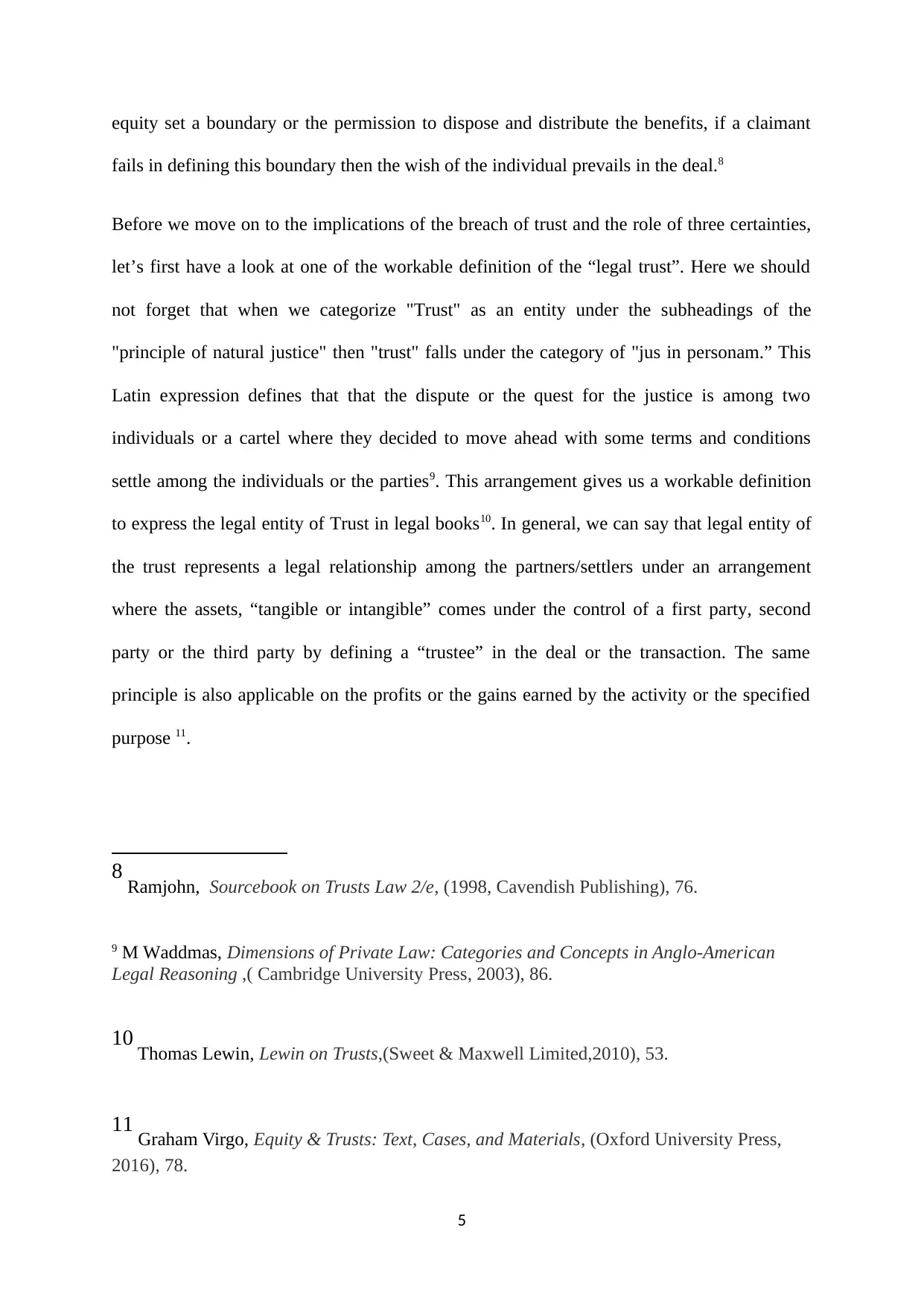
equity set a boundary or the permission to dispose and distribute the benefits, if a claimant
fails in defining this boundary then the wish of the individual prevails in the deal.8
Before we move on to the implications of the breach of trust and the role of three certainties,
let’s first have a look at one of the workable definition of the “legal trust”. Here we should
not forget that when we categorize "Trust" as an entity under the subheadings of the
"principle of natural justice" then "trust" falls under the category of "jus in personam.” This
Latin expression defines that that the dispute or the quest for the justice is among two
individuals or a cartel where they decided to move ahead with some terms and conditions
settle among the individuals or the parties9. This arrangement gives us a workable definition
to express the legal entity of Trust in legal books10. In general, we can say that legal entity of
the trust represents a legal relationship among the partners/settlers under an arrangement
where the assets, “tangible or intangible” comes under the control of a first party, second
party or the third party by defining a “trustee” in the deal or the transaction. The same
principle is also applicable on the profits or the gains earned by the activity or the specified
purpose 11.
8 Ramjohn, Sourcebook on Trusts Law 2/e, (1998, Cavendish Publishing), 76.
9 M Waddmas, Dimensions of Private Law: Categories and Concepts in Anglo-American
Legal Reasoning ,( Cambridge University Press, 2003), 86.
10 Thomas Lewin, Lewin on Trusts,(Sweet & Maxwell Limited,2010), 53.
11 Graham Virgo, Equity & Trusts: Text, Cases, and Materials, (Oxford University Press,
2016), 78.
5
fails in defining this boundary then the wish of the individual prevails in the deal.8
Before we move on to the implications of the breach of trust and the role of three certainties,
let’s first have a look at one of the workable definition of the “legal trust”. Here we should
not forget that when we categorize "Trust" as an entity under the subheadings of the
"principle of natural justice" then "trust" falls under the category of "jus in personam.” This
Latin expression defines that that the dispute or the quest for the justice is among two
individuals or a cartel where they decided to move ahead with some terms and conditions
settle among the individuals or the parties9. This arrangement gives us a workable definition
to express the legal entity of Trust in legal books10. In general, we can say that legal entity of
the trust represents a legal relationship among the partners/settlers under an arrangement
where the assets, “tangible or intangible” comes under the control of a first party, second
party or the third party by defining a “trustee” in the deal or the transaction. The same
principle is also applicable on the profits or the gains earned by the activity or the specified
purpose 11.
8 Ramjohn, Sourcebook on Trusts Law 2/e, (1998, Cavendish Publishing), 76.
9 M Waddmas, Dimensions of Private Law: Categories and Concepts in Anglo-American
Legal Reasoning ,( Cambridge University Press, 2003), 86.
10 Thomas Lewin, Lewin on Trusts,(Sweet & Maxwell Limited,2010), 53.
11 Graham Virgo, Equity & Trusts: Text, Cases, and Materials, (Oxford University Press,
2016), 78.
5
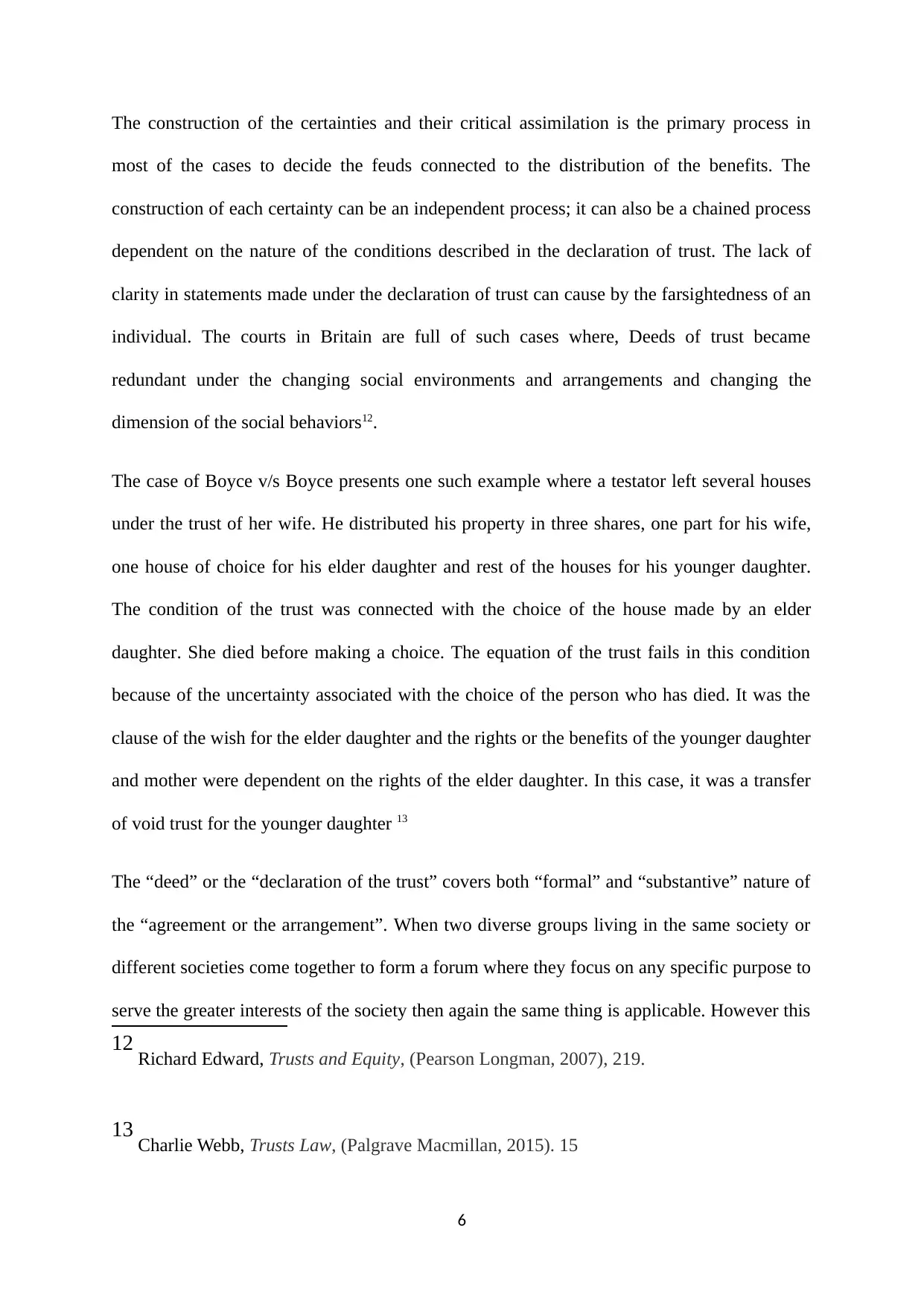
The construction of the certainties and their critical assimilation is the primary process in
most of the cases to decide the feuds connected to the distribution of the benefits. The
construction of each certainty can be an independent process; it can also be a chained process
dependent on the nature of the conditions described in the declaration of trust. The lack of
clarity in statements made under the declaration of trust can cause by the farsightedness of an
individual. The courts in Britain are full of such cases where, Deeds of trust became
redundant under the changing social environments and arrangements and changing the
dimension of the social behaviors12.
The case of Boyce v/s Boyce presents one such example where a testator left several houses
under the trust of her wife. He distributed his property in three shares, one part for his wife,
one house of choice for his elder daughter and rest of the houses for his younger daughter.
The condition of the trust was connected with the choice of the house made by an elder
daughter. She died before making a choice. The equation of the trust fails in this condition
because of the uncertainty associated with the choice of the person who has died. It was the
clause of the wish for the elder daughter and the rights or the benefits of the younger daughter
and mother were dependent on the rights of the elder daughter. In this case, it was a transfer
of void trust for the younger daughter 13
The “deed” or the “declaration of the trust” covers both “formal” and “substantive” nature of
the “agreement or the arrangement”. When two diverse groups living in the same society or
different societies come together to form a forum where they focus on any specific purpose to
serve the greater interests of the society then again the same thing is applicable. However this
12 Richard Edward, Trusts and Equity, (Pearson Longman, 2007), 219.
13 Charlie Webb, Trusts Law, (Palgrave Macmillan, 2015). 15
6
most of the cases to decide the feuds connected to the distribution of the benefits. The
construction of each certainty can be an independent process; it can also be a chained process
dependent on the nature of the conditions described in the declaration of trust. The lack of
clarity in statements made under the declaration of trust can cause by the farsightedness of an
individual. The courts in Britain are full of such cases where, Deeds of trust became
redundant under the changing social environments and arrangements and changing the
dimension of the social behaviors12.
The case of Boyce v/s Boyce presents one such example where a testator left several houses
under the trust of her wife. He distributed his property in three shares, one part for his wife,
one house of choice for his elder daughter and rest of the houses for his younger daughter.
The condition of the trust was connected with the choice of the house made by an elder
daughter. She died before making a choice. The equation of the trust fails in this condition
because of the uncertainty associated with the choice of the person who has died. It was the
clause of the wish for the elder daughter and the rights or the benefits of the younger daughter
and mother were dependent on the rights of the elder daughter. In this case, it was a transfer
of void trust for the younger daughter 13
The “deed” or the “declaration of the trust” covers both “formal” and “substantive” nature of
the “agreement or the arrangement”. When two diverse groups living in the same society or
different societies come together to form a forum where they focus on any specific purpose to
serve the greater interests of the society then again the same thing is applicable. However this
12 Richard Edward, Trusts and Equity, (Pearson Longman, 2007), 219.
13 Charlie Webb, Trusts Law, (Palgrave Macmillan, 2015). 15
6
⊘ This is a preview!⊘
Do you want full access?
Subscribe today to unlock all pages.

Trusted by 1+ million students worldwide
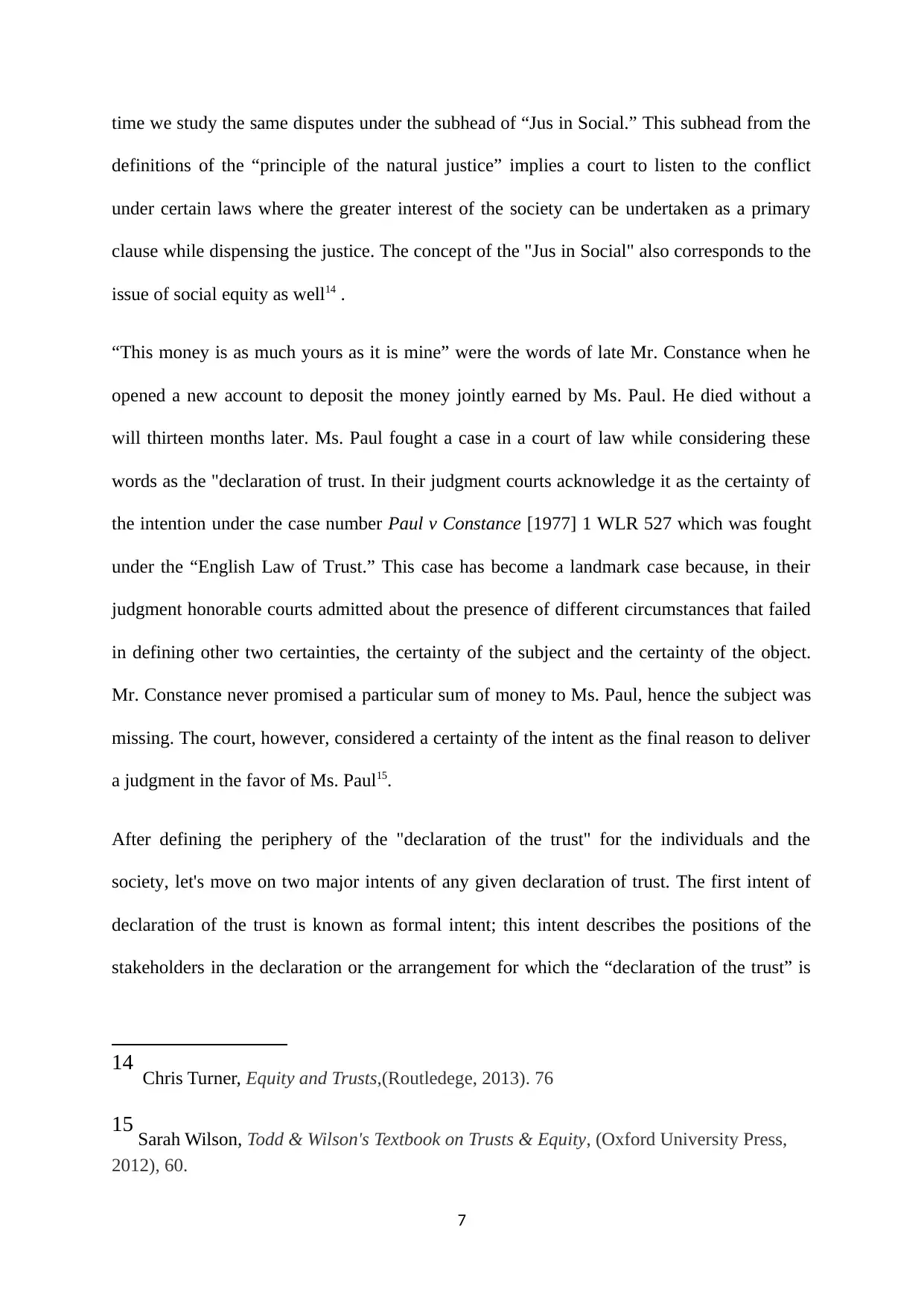
time we study the same disputes under the subhead of “Jus in Social.” This subhead from the
definitions of the “principle of the natural justice” implies a court to listen to the conflict
under certain laws where the greater interest of the society can be undertaken as a primary
clause while dispensing the justice. The concept of the "Jus in Social" also corresponds to the
issue of social equity as well14 .
“This money is as much yours as it is mine” were the words of late Mr. Constance when he
opened a new account to deposit the money jointly earned by Ms. Paul. He died without a
will thirteen months later. Ms. Paul fought a case in a court of law while considering these
words as the "declaration of trust. In their judgment courts acknowledge it as the certainty of
the intention under the case number Paul v Constance [1977] 1 WLR 527 which was fought
under the “English Law of Trust.” This case has become a landmark case because, in their
judgment honorable courts admitted about the presence of different circumstances that failed
in defining other two certainties, the certainty of the subject and the certainty of the object.
Mr. Constance never promised a particular sum of money to Ms. Paul, hence the subject was
missing. The court, however, considered a certainty of the intent as the final reason to deliver
a judgment in the favor of Ms. Paul15.
After defining the periphery of the "declaration of the trust" for the individuals and the
society, let's move on two major intents of any given declaration of trust. The first intent of
declaration of the trust is known as formal intent; this intent describes the positions of the
stakeholders in the declaration or the arrangement for which the “declaration of the trust” is
14 Chris Turner, Equity and Trusts,(Routledege, 2013). 76
15 Sarah Wilson, Todd & Wilson's Textbook on Trusts & Equity, (Oxford University Press,
2012), 60.
7
definitions of the “principle of the natural justice” implies a court to listen to the conflict
under certain laws where the greater interest of the society can be undertaken as a primary
clause while dispensing the justice. The concept of the "Jus in Social" also corresponds to the
issue of social equity as well14 .
“This money is as much yours as it is mine” were the words of late Mr. Constance when he
opened a new account to deposit the money jointly earned by Ms. Paul. He died without a
will thirteen months later. Ms. Paul fought a case in a court of law while considering these
words as the "declaration of trust. In their judgment courts acknowledge it as the certainty of
the intention under the case number Paul v Constance [1977] 1 WLR 527 which was fought
under the “English Law of Trust.” This case has become a landmark case because, in their
judgment honorable courts admitted about the presence of different circumstances that failed
in defining other two certainties, the certainty of the subject and the certainty of the object.
Mr. Constance never promised a particular sum of money to Ms. Paul, hence the subject was
missing. The court, however, considered a certainty of the intent as the final reason to deliver
a judgment in the favor of Ms. Paul15.
After defining the periphery of the "declaration of the trust" for the individuals and the
society, let's move on two major intents of any given declaration of trust. The first intent of
declaration of the trust is known as formal intent; this intent describes the positions of the
stakeholders in the declaration or the arrangement for which the “declaration of the trust” is
14 Chris Turner, Equity and Trusts,(Routledege, 2013). 76
15 Sarah Wilson, Todd & Wilson's Textbook on Trusts & Equity, (Oxford University Press,
2012), 60.
7
Paraphrase This Document
Need a fresh take? Get an instant paraphrase of this document with our AI Paraphraser
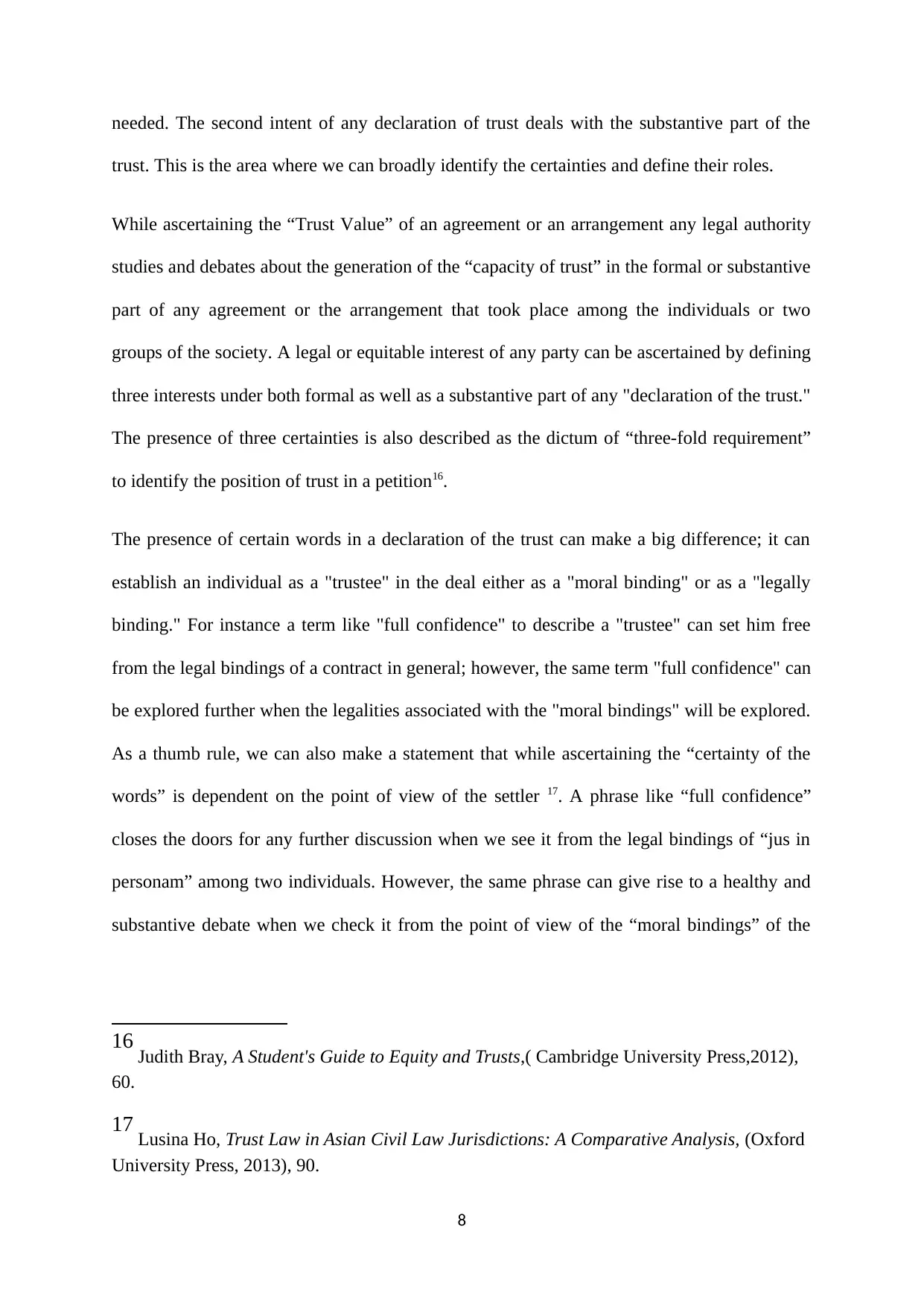
needed. The second intent of any declaration of trust deals with the substantive part of the
trust. This is the area where we can broadly identify the certainties and define their roles.
While ascertaining the “Trust Value” of an agreement or an arrangement any legal authority
studies and debates about the generation of the “capacity of trust” in the formal or substantive
part of any agreement or the arrangement that took place among the individuals or two
groups of the society. A legal or equitable interest of any party can be ascertained by defining
three interests under both formal as well as a substantive part of any "declaration of the trust."
The presence of three certainties is also described as the dictum of “three-fold requirement”
to identify the position of trust in a petition16.
The presence of certain words in a declaration of the trust can make a big difference; it can
establish an individual as a "trustee" in the deal either as a "moral binding" or as a "legally
binding." For instance a term like "full confidence" to describe a "trustee" can set him free
from the legal bindings of a contract in general; however, the same term "full confidence" can
be explored further when the legalities associated with the "moral bindings" will be explored.
As a thumb rule, we can also make a statement that while ascertaining the “certainty of the
words” is dependent on the point of view of the settler 17. A phrase like “full confidence”
closes the doors for any further discussion when we see it from the legal bindings of “jus in
personam” among two individuals. However, the same phrase can give rise to a healthy and
substantive debate when we check it from the point of view of the “moral bindings” of the
16 Judith Bray, A Student's Guide to Equity and Trusts,( Cambridge University Press,2012),
60.
17 Lusina Ho, Trust Law in Asian Civil Law Jurisdictions: A Comparative Analysis, (Oxford
University Press, 2013), 90.
8
trust. This is the area where we can broadly identify the certainties and define their roles.
While ascertaining the “Trust Value” of an agreement or an arrangement any legal authority
studies and debates about the generation of the “capacity of trust” in the formal or substantive
part of any agreement or the arrangement that took place among the individuals or two
groups of the society. A legal or equitable interest of any party can be ascertained by defining
three interests under both formal as well as a substantive part of any "declaration of the trust."
The presence of three certainties is also described as the dictum of “three-fold requirement”
to identify the position of trust in a petition16.
The presence of certain words in a declaration of the trust can make a big difference; it can
establish an individual as a "trustee" in the deal either as a "moral binding" or as a "legally
binding." For instance a term like "full confidence" to describe a "trustee" can set him free
from the legal bindings of a contract in general; however, the same term "full confidence" can
be explored further when the legalities associated with the "moral bindings" will be explored.
As a thumb rule, we can also make a statement that while ascertaining the “certainty of the
words” is dependent on the point of view of the settler 17. A phrase like “full confidence”
closes the doors for any further discussion when we see it from the legal bindings of “jus in
personam” among two individuals. However, the same phrase can give rise to a healthy and
substantive debate when we check it from the point of view of the “moral bindings” of the
16 Judith Bray, A Student's Guide to Equity and Trusts,( Cambridge University Press,2012),
60.
17 Lusina Ho, Trust Law in Asian Civil Law Jurisdictions: A Comparative Analysis, (Oxford
University Press, 2013), 90.
8
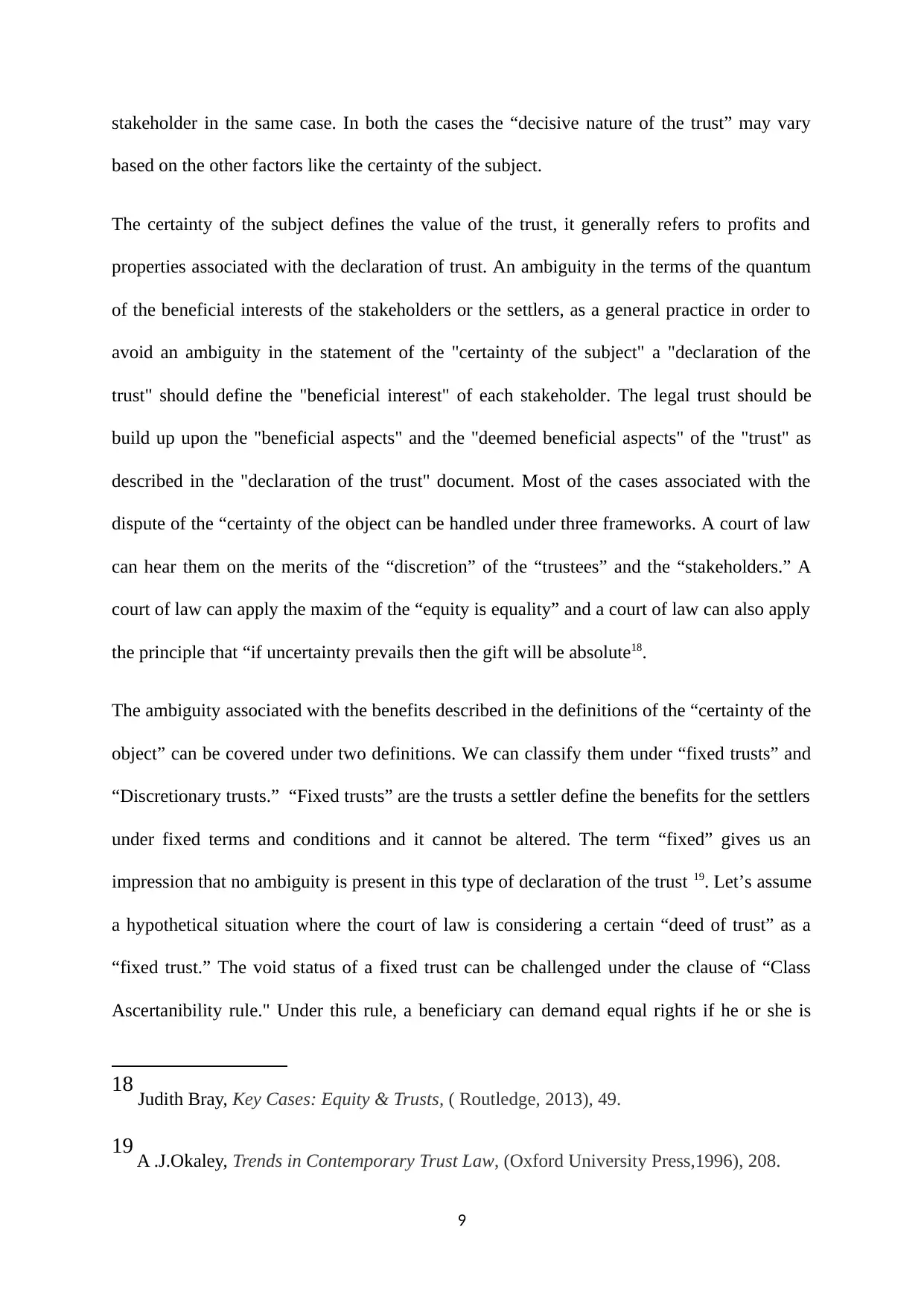
stakeholder in the same case. In both the cases the “decisive nature of the trust” may vary
based on the other factors like the certainty of the subject.
The certainty of the subject defines the value of the trust, it generally refers to profits and
properties associated with the declaration of trust. An ambiguity in the terms of the quantum
of the beneficial interests of the stakeholders or the settlers, as a general practice in order to
avoid an ambiguity in the statement of the "certainty of the subject" a "declaration of the
trust" should define the "beneficial interest" of each stakeholder. The legal trust should be
build up upon the "beneficial aspects" and the "deemed beneficial aspects" of the "trust" as
described in the "declaration of the trust" document. Most of the cases associated with the
dispute of the “certainty of the object can be handled under three frameworks. A court of law
can hear them on the merits of the “discretion” of the “trustees” and the “stakeholders.” A
court of law can apply the maxim of the “equity is equality” and a court of law can also apply
the principle that “if uncertainty prevails then the gift will be absolute18.
The ambiguity associated with the benefits described in the definitions of the “certainty of the
object” can be covered under two definitions. We can classify them under “fixed trusts” and
“Discretionary trusts.” “Fixed trusts” are the trusts a settler define the benefits for the settlers
under fixed terms and conditions and it cannot be altered. The term “fixed” gives us an
impression that no ambiguity is present in this type of declaration of the trust 19. Let’s assume
a hypothetical situation where the court of law is considering a certain “deed of trust” as a
“fixed trust.” The void status of a fixed trust can be challenged under the clause of “Class
Ascertanibility rule." Under this rule, a beneficiary can demand equal rights if he or she is
18 Judith Bray, Key Cases: Equity & Trusts, ( Routledge, 2013), 49.
19 A .J.Okaley, Trends in Contemporary Trust Law, (Oxford University Press,1996), 208.
9
based on the other factors like the certainty of the subject.
The certainty of the subject defines the value of the trust, it generally refers to profits and
properties associated with the declaration of trust. An ambiguity in the terms of the quantum
of the beneficial interests of the stakeholders or the settlers, as a general practice in order to
avoid an ambiguity in the statement of the "certainty of the subject" a "declaration of the
trust" should define the "beneficial interest" of each stakeholder. The legal trust should be
build up upon the "beneficial aspects" and the "deemed beneficial aspects" of the "trust" as
described in the "declaration of the trust" document. Most of the cases associated with the
dispute of the “certainty of the object can be handled under three frameworks. A court of law
can hear them on the merits of the “discretion” of the “trustees” and the “stakeholders.” A
court of law can apply the maxim of the “equity is equality” and a court of law can also apply
the principle that “if uncertainty prevails then the gift will be absolute18.
The ambiguity associated with the benefits described in the definitions of the “certainty of the
object” can be covered under two definitions. We can classify them under “fixed trusts” and
“Discretionary trusts.” “Fixed trusts” are the trusts a settler define the benefits for the settlers
under fixed terms and conditions and it cannot be altered. The term “fixed” gives us an
impression that no ambiguity is present in this type of declaration of the trust 19. Let’s assume
a hypothetical situation where the court of law is considering a certain “deed of trust” as a
“fixed trust.” The void status of a fixed trust can be challenged under the clause of “Class
Ascertanibility rule." Under this rule, a beneficiary can demand equal rights if he or she is
18 Judith Bray, Key Cases: Equity & Trusts, ( Routledge, 2013), 49.
19 A .J.Okaley, Trends in Contemporary Trust Law, (Oxford University Press,1996), 208.
9
⊘ This is a preview!⊘
Do you want full access?
Subscribe today to unlock all pages.

Trusted by 1+ million students worldwide
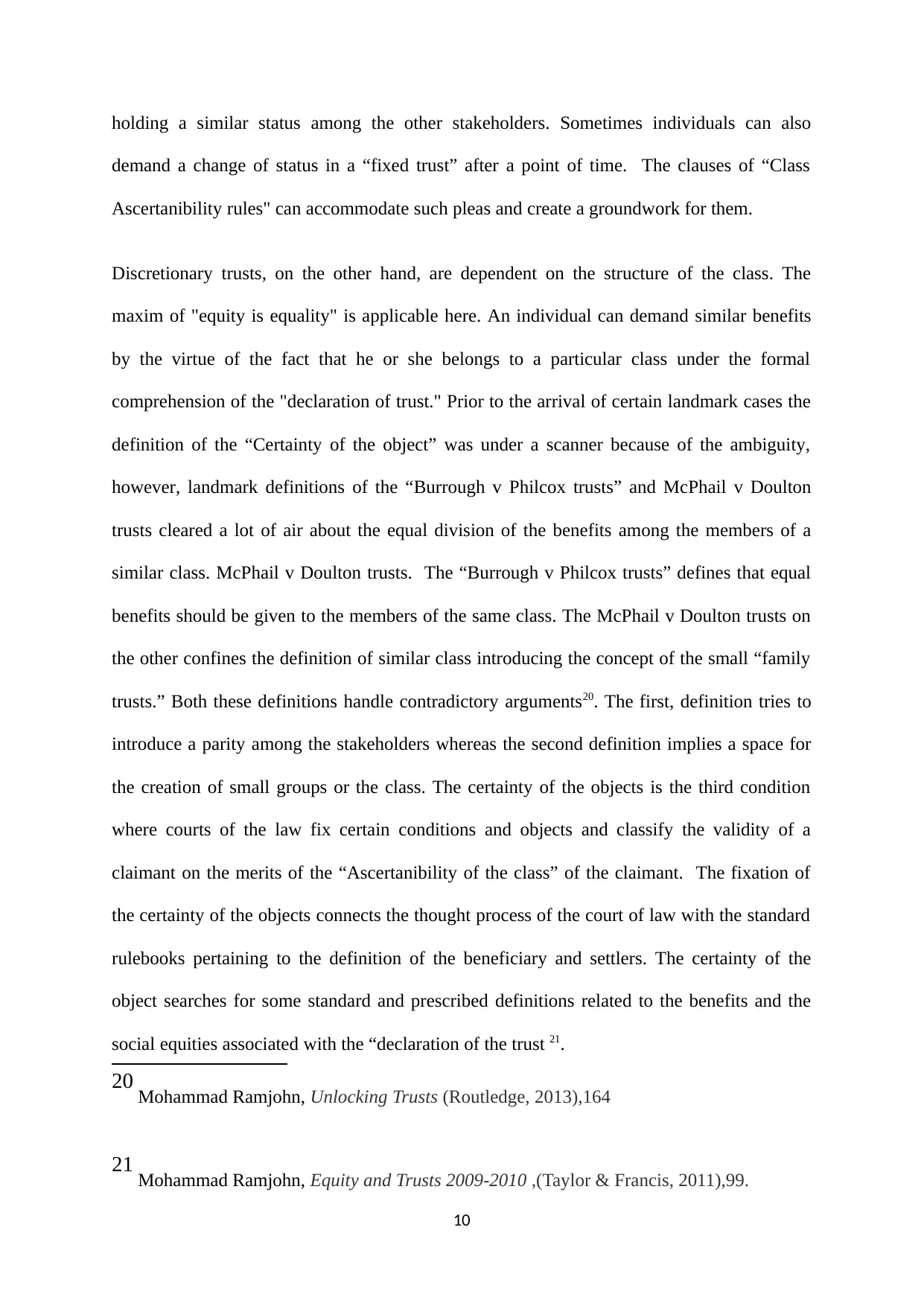
holding a similar status among the other stakeholders. Sometimes individuals can also
demand a change of status in a “fixed trust” after a point of time. The clauses of “Class
Ascertanibility rules" can accommodate such pleas and create a groundwork for them.
Discretionary trusts, on the other hand, are dependent on the structure of the class. The
maxim of "equity is equality" is applicable here. An individual can demand similar benefits
by the virtue of the fact that he or she belongs to a particular class under the formal
comprehension of the "declaration of trust." Prior to the arrival of certain landmark cases the
definition of the “Certainty of the object” was under a scanner because of the ambiguity,
however, landmark definitions of the “Burrough v Philcox trusts” and McPhail v Doulton
trusts cleared a lot of air about the equal division of the benefits among the members of a
similar class. McPhail v Doulton trusts. The “Burrough v Philcox trusts” defines that equal
benefits should be given to the members of the same class. The McPhail v Doulton trusts on
the other confines the definition of similar class introducing the concept of the small “family
trusts.” Both these definitions handle contradictory arguments20. The first, definition tries to
introduce a parity among the stakeholders whereas the second definition implies a space for
the creation of small groups or the class. The certainty of the objects is the third condition
where courts of the law fix certain conditions and objects and classify the validity of a
claimant on the merits of the “Ascertanibility of the class” of the claimant. The fixation of
the certainty of the objects connects the thought process of the court of law with the standard
rulebooks pertaining to the definition of the beneficiary and settlers. The certainty of the
object searches for some standard and prescribed definitions related to the benefits and the
social equities associated with the “declaration of the trust 21.
20 Mohammad Ramjohn, Unlocking Trusts (Routledge, 2013),164
21 Mohammad Ramjohn, Equity and Trusts 2009-2010 ,(Taylor & Francis, 2011),99.
10
demand a change of status in a “fixed trust” after a point of time. The clauses of “Class
Ascertanibility rules" can accommodate such pleas and create a groundwork for them.
Discretionary trusts, on the other hand, are dependent on the structure of the class. The
maxim of "equity is equality" is applicable here. An individual can demand similar benefits
by the virtue of the fact that he or she belongs to a particular class under the formal
comprehension of the "declaration of trust." Prior to the arrival of certain landmark cases the
definition of the “Certainty of the object” was under a scanner because of the ambiguity,
however, landmark definitions of the “Burrough v Philcox trusts” and McPhail v Doulton
trusts cleared a lot of air about the equal division of the benefits among the members of a
similar class. McPhail v Doulton trusts. The “Burrough v Philcox trusts” defines that equal
benefits should be given to the members of the same class. The McPhail v Doulton trusts on
the other confines the definition of similar class introducing the concept of the small “family
trusts.” Both these definitions handle contradictory arguments20. The first, definition tries to
introduce a parity among the stakeholders whereas the second definition implies a space for
the creation of small groups or the class. The certainty of the objects is the third condition
where courts of the law fix certain conditions and objects and classify the validity of a
claimant on the merits of the “Ascertanibility of the class” of the claimant. The fixation of
the certainty of the objects connects the thought process of the court of law with the standard
rulebooks pertaining to the definition of the beneficiary and settlers. The certainty of the
object searches for some standard and prescribed definitions related to the benefits and the
social equities associated with the “declaration of the trust 21.
20 Mohammad Ramjohn, Unlocking Trusts (Routledge, 2013),164
21 Mohammad Ramjohn, Equity and Trusts 2009-2010 ,(Taylor & Francis, 2011),99.
10
Paraphrase This Document
Need a fresh take? Get an instant paraphrase of this document with our AI Paraphraser
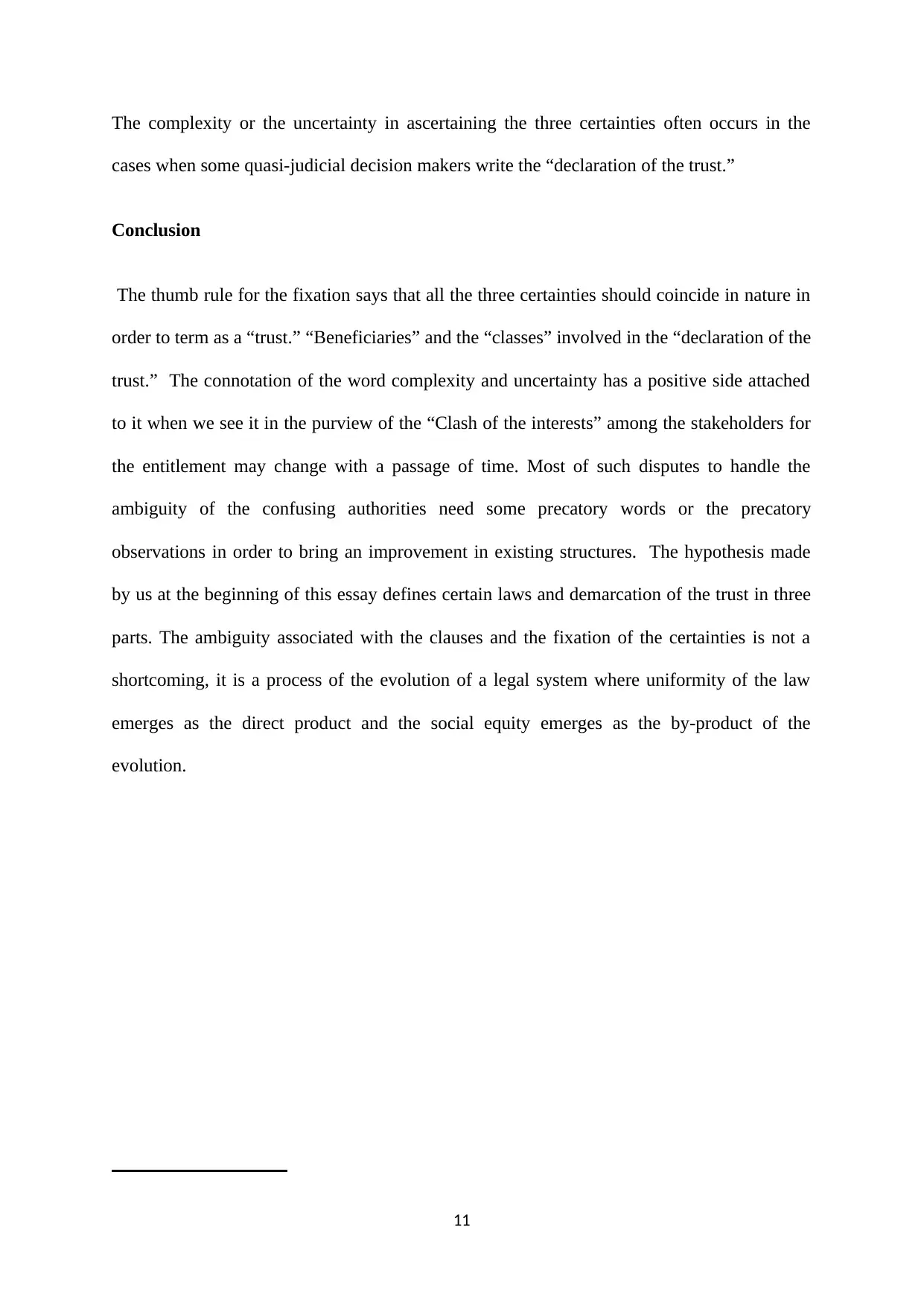
The complexity or the uncertainty in ascertaining the three certainties often occurs in the
cases when some quasi-judicial decision makers write the “declaration of the trust.”
Conclusion
The thumb rule for the fixation says that all the three certainties should coincide in nature in
order to term as a “trust.” “Beneficiaries” and the “classes” involved in the “declaration of the
trust.” The connotation of the word complexity and uncertainty has a positive side attached
to it when we see it in the purview of the “Clash of the interests” among the stakeholders for
the entitlement may change with a passage of time. Most of such disputes to handle the
ambiguity of the confusing authorities need some precatory words or the precatory
observations in order to bring an improvement in existing structures. The hypothesis made
by us at the beginning of this essay defines certain laws and demarcation of the trust in three
parts. The ambiguity associated with the clauses and the fixation of the certainties is not a
shortcoming, it is a process of the evolution of a legal system where uniformity of the law
emerges as the direct product and the social equity emerges as the by-product of the
evolution.
11
cases when some quasi-judicial decision makers write the “declaration of the trust.”
Conclusion
The thumb rule for the fixation says that all the three certainties should coincide in nature in
order to term as a “trust.” “Beneficiaries” and the “classes” involved in the “declaration of the
trust.” The connotation of the word complexity and uncertainty has a positive side attached
to it when we see it in the purview of the “Clash of the interests” among the stakeholders for
the entitlement may change with a passage of time. Most of such disputes to handle the
ambiguity of the confusing authorities need some precatory words or the precatory
observations in order to bring an improvement in existing structures. The hypothesis made
by us at the beginning of this essay defines certain laws and demarcation of the trust in three
parts. The ambiguity associated with the clauses and the fixation of the certainties is not a
shortcoming, it is a process of the evolution of a legal system where uniformity of the law
emerges as the direct product and the social equity emerges as the by-product of the
evolution.
11

12
⊘ This is a preview!⊘
Do you want full access?
Subscribe today to unlock all pages.

Trusted by 1+ million students worldwide
1 out of 14
Your All-in-One AI-Powered Toolkit for Academic Success.
+13062052269
info@desklib.com
Available 24*7 on WhatsApp / Email
![[object Object]](/_next/static/media/star-bottom.7253800d.svg)
Unlock your academic potential
Copyright © 2020–2025 A2Z Services. All Rights Reserved. Developed and managed by ZUCOL.